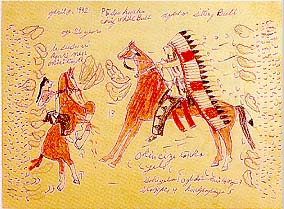28. "The Battle
of the Little Big Horn River (Montana), June 25, 1876."
White Bull counts the first coup upon a wounded soldier. White Bull drew
the soldier armed with both his pistol and carbine.
29. "The Battle
of the Little Big Horn River (Montana), June 25, 1876."
In this scene, White Bull wrestles with a soldier, who almost overpowers
him. But White Bull was able to kill the soldier and take his weapons and
ammunition. The ground around White Bull and the soldier is shown trampled
by the Indians and soldiers during the course of the battle.
30. "The Battle
of the Little Big Horn River (Montana), June 25, 1876."
White Bull counts a first coup on a soldier he has just shot. White Bull
stated, "I hit him, a Cheyenne struck second."
31. "The Battle
of the Little Big Horn River (Montana), June 25, 1876."
White Bull counts a second coup on a soldier shot by a Cheyenne. White
Bull stated, "The Cheyenne struck him first, I took the second coup."
A short time after this coup, White Bull was struck in the ankle by a spent
bullet and was unable to continue taking an active part in the battle. But
at this point in the engagement, only a few of Custer's soldiers were alive.
32. "The Battle
of the Little Big Horn River (Montana), June 26, 1876."
In this drawing, White Bull takes horses from General Terry's advancing
column. The tepee on the right represents the soldiers' camp from which
White Bull's tracks lead. White Bull stated, "This made my name known,
taken from those coming below, soldiers and crows were camped there. |
33. "The Black
Hills (South Dakota), August, 1876."
White Bull steals two horses from a white men's camp. He notes that this
was "done while they slept, a good job."
34. "The
Black Hills (South Dakota), September, 1876."
White Bull steals horses from a camp of white men, who chased him for
a long distance. The camp with rifle smoke is indicated to the right of
White Bull.
35. "Yellowstone
River (Montana), October 1876."
During a battle with soldiers under the command of Colonel E. S. Otis,
White Bull was shot in the left arm. White Bull drew himself wearing his
war charm and his horse was decorated for war with a feather attached to
the bridle and on the horse's tail.

White Bull depicts himself wounding a Shoshoni Indian who
was fighting with the U.S. Cavalry against the Sioux and Cheyenne at the
Battle of the Rosebud River in Montana, June, 1876.
36. "Near the
Big Bend of the Yellowstone River (Montana), October 1876."
White Bull saves White Deer, who was wounded by white buffalo hunters.
White Bull stated, "This is White Deer, he is a Minniconjou Sioux,
this was a hard thing to do, but I could, so I carried him away on my back,
this is one of the hardest things to do, and one of the best things to tell,
this was one of the deeds that put a man among the famous." |

